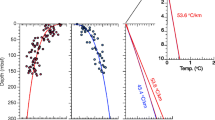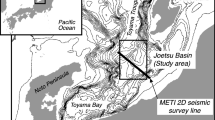Abstract
Several cold vents are observed at the northern Cascadia margin offshore Vancouver Island in a 10 km2 region around Integrated Ocean Drilling Program Expedition 311 Site U1328. All vents are linked to fault systems that provide pathways for upward migrating fluids and at three vents methane plumes were detected acoustically in the water column. Downhole temperature measurements at Site U1328 revealed a geothermal gradient of 0.056 ± 0.004°C/m. With the measured in situ pore-water salinities the base of methane hydrate stability is predicted at 218–245 meters below seafloor. Heat-probe measurements conducted across Site U1328 and other nearby vents showed an average thermal gradient of 0.054 ± 0.004°C/m. Assuming that the bottom-simulating reflector (BSR) marks the base of the gas hydrate stability zone variations in BSR depths were used to investigate the linkages between the base of the gas hydrate stability zone and fluid migration. Variations in BSR depth can be attributed to lithology-related velocity changes or variations of in situ pore-fluid compositions. Prominent BSR depressions and reduced heat flow are seen below topographic highs, but only a portion of the heat flow reduction can be due to topography-linked cooling. More than half of the reduction may be due to thrust faulting or to pore-water freshening. Distinct changes in BSR depth below seafloor are observed at all cold vents studied and some portion of the observed decrease in the BSR depth was attributed to fault-related upwelling of warmer fluids. The observed decrease in BSR depth below seafloor underneath the vents ranges between 7 and 24 m (equivalent to temperature shifts of 0.07–0.15°C).
















Similar content being viewed by others
References
Chapman NR, Gettrust J, Walia R, Hannay D, Spence GD, Wood W, Hyndman RD (2002) High resolution deep-towed multichannel seismic survey of deep sea gas hydrates off western Canada. Geophysics 67:1038–1047
Davis EE, Hyndman RD, Villinger H (1990) Rates of uid expulsion across the northern Cascadia accretionary prism: constraints from new heat ow and multichannel seismic reection data. J Geophys Res 95:8869–8889
Englezos P, Bishnoi PR (1988) Prediction of gas hydrate formation in aqueous solutions. Am Inst Chem Eng 34:1718–1721
Fink CR, Spence GD (1999) Gas hydrate distribution off vancouver island from multi-frequency single channel seismic reflection data. J Geophys Res 104:2909–2922
Ganguly N, Spence GD, Chapman NR, Hyndman RD (2000) Heat flow variations from bottom simulating reflectors on the Cascadia margin. Mar Geol 164:53–68
Haacke R, Hamilton T, Enkin R, Esteban L, Pohlman J (2008) PGC2008007: pacific geoscience centre marine gas hydrates cruise to the frontal ridge and mid-slope areas of the vancouver island accretionary wedge, PGC2008007 Cruise report, Geological Survey of Canada, p 147
He T, Spence GD, Riedel M, Hyndman RD, Chapman NR (2007) Fluid flow and origin of a carbonate mound offshore vancouver island: seismic and heat flow constraints. Mar Geol 239:83–98. doi:10.1016/j.margeo.2007.01.002
Heeschen KU, Tréhu AM, Collier RW, Suess E, Rehder G (2003) Distribution and height of methane bubble plumes on the Cascadia margin offshore oregon from acoustic imaging. Geophys Res Let 30:1643–1647. doi:10.1029/2003GL016974
Hobro JWD, Minshull TA, Singh SC, Chand S (2005) A three-dimensional seismic tomographic study of the gas hydrate stability zone, offshore vancouver island. J Geophys Res 110:B09102. doi:10.1029/2004JB003477
Hornbach MJ, Ruppel C, Van Dover CL (2007) Three-dimensional structure of fluid conduits sustaining an active deep marine cold seep. Geophys Res Lett 34:L05601. doi:10.1029/2006GL028859
Hyndman RD (1995) The Lithoprobe corridor across the vancouver island continental margin: the structural and tectonic consequences of subduction. Can J Earth Sci 32:1777–1802
Hyndman RD, Davis EE (1992) A mechanism for the formation of methane hydrate and seafloor bottom-simulating reflectors by vertical fluid expulsion. J Geophys Res 97:7025–7041
Hyndman RD, Wang K, Yuan T, Spence GD (1993) Tectonic sediment thickening: fluid expulsion and the thermal regime of subduction zone accretionary prisms: the cascadia margin off_vancouver island. J Geophys Res 98:21865–21876
Hyndman RD, Spence GD, Chapman NR, Riedel M, Edwards RN (2001) Geophysical studies of marine gas hydrates in northern Cascadia. AGU monograph, natural gas hydrates: occurrence, distribution, and dynamics, pp 273–295
Kastner M, Kvenvolden KA, Whiticar MJ, Camerlenghi A, Lorenson TD (1995) Relation between pore fluid chemistry and gas hydrate associated with bottom-simulating reflectors at the Cascadia margin, sites 889 and 892, Proceedings of the ODP, scientific results, 146 (part 1), College Station, TX (Ocean Drilling Program), pp 175–187
Kinoshita M, Goto S, Gulick SP, Mikada H (2002) Very focused expulsion of pore fluid along the western Nankai accretionary complex detected by closely-spaced heat flow measurements: Eos transactions, American geophysical union, fall meet. Suppl., 83(47), Abstract T11B–1247
Lachenbruch AH (1968) Rapid estimation of the topographic disturbance to superficial thermal gradients. Rev Geophys 6:365–400
Liu X, Flemings PB (2006) Passing gas through the hydrate stability zone at southern hydrate ridge, offshore oregon. Earth Planet Sci Lett 241:211–226
Liu X, Flemings PB (2007) Dynamic multiphase flow model of hydrate formation in marine sediments. J Geophys Res 112:B03101. doi:10.1029/2005JB004227
Matsumoto R, Hiruta A, Takeuchi E, Ishizaki O, Aoyama C, Machiyama H (2006) Giant methane plumes, gas hydrate mounds, and large pockmarks on the umitaka spur, eastern margin of Japan sea: impact of the sea level fall during the LGM, Eos transaction, American geophysical union, 87(52), fall meet. Suppl, Abstract OS12C-02
Novosel I, Spence GD, Hyndman RD (2005) Reduced magnetization produced by increased methane flux at a gas hydrate vent. Mar Geol 216:265–274
Pohlman J, Spence GD, Chapman NR, Hyndman RD, Grabowski KS, Coffin RB (2003) Evidence for anaerobic methane oxidation in gas hydrate rich sediments on the northern Cascadia margin offshore vancouver island: nice, France, EGS-AGU-EUG joint assembly, April 6–11
Riedel M (2007) 4D seismic time-lapse monitoring of an active cold vent, northern Cascadia margin. Mar Geophys Res 28(4):355–371. doi:10.1007/s11001-007-9037-2
Riedel M, Collett TS, Malone MJ, and the Expedition 311 Scientists (2006a) Proceedings of the IODP, 311: Washington, DC (Integrated Ocean Drilling Program Management International, Inc). doi:10.2204/iodp.proc.311.2006
Riedel M, Hyndman RD, Spence GD, Chapman NR (2002) Seismic investigations of a vent field associated with gas hydrates, offshore vancouver island. J Geophys Res 107(B9):2200. doi:10.1029/2001JB000269
Riedel M, Novosel I, Spence GD, Hyndman RD, Chapman RN, Solem RC, Lewis T (2006b) Geophysical and geochemical signatures associated with gas hydrate related venting at the north Cascadia margin. GSA bulletin 118. doi:10.1130/B25720.1
Schwalenberg K, Willoughby EC, Mir R, Edwards RN (2005) Marine gas hydrate signatures in Cascadia and their correlation with seismic blank zones. First Break 23:57–63
Sloan ED (1997) Clathrate hydrates of natural gas, 2nd edn. Marcel Dekker, New York
Solem RC, Spence GD, Vukajlovich D, Hyndman RD, Riedel M, Novosel I, Kastner M (2002) Methane advection and gas hydrate formation within an active vent field offshore vancouver island, proceedings of the 4th international conference on gas hydrate, Yokohama
Spence GD, Hyndman RD, Chapman NR, Riedel M, Edwards RN, Yuan J (2000) Cascadia margin, northeast Pacific ocean: hydrate. Distribution from geophysical observations. In: Max MD (ed) Natural gas hydrates. Kluwer Academic Publishers, Dordrecht, pp 183–198
Tréhu AM, Bohrmann G, Rack FR, Torres ME et al (2003) Proceedings of the ODP, initial report, 204. ocean drilling program, Texas A&M University, College Station TX, 77845-9547, USA
Westbrook GK, Carson B, Musgrave RJ et al (1994) Proceedings of the ocean drilling program, initial report, vol. 146 (part 1). Ocean drilling program, College Station, Texas
Willoughby EC, Schwalenberg K, Edwards RN, Spence GD, Hyndman RD (2005) Assessment of marine gas hydrate deposits: a comparative study of seismic, electromagnetic and seafloor compliance methods, international conference on gas hydrates, Trondheim, Norway
Wood WT, Gettrust JF, Chapman NR, Spence GD, Hyndman RD (2002) Decreased stability of methane gas hydrates in marine sediments owing to phase-boundary roughness. Nature 420:656–660
Yuan T, Spence GD, Hyndman RD (1994) Seismic velocities and inferred porosities in the accretionary wedge sediments at the Cascadia margin. J Geophys Res 99:4413–4427
Yuan T, Hyndman RD, Spence GD, Desmos B (1996) Seismic velocity increase and deep-sea gas hydrate concentration above a bottom-simulating reflector on the northern Cascadia continental slope. J Geophys Res 101:13665–13671
Zühlsdorff L, Spiess V (2004) Three-dimensional seismic characterization of a venting site reveals compelling indications of natural hydraulic fracturing. Geology 32(2):101–104
Acknowledgments
We thank the Integrated Ocean Drilling Program (IODP), the National Science Foundation, and The US Department of Energy, National Gas Hydrate Research Program for making this research possible. We acknowledge the contribution of the shipboard party of IODP Expedition 311. The authors would further like to acknowledge the contributions of the Coast Guard crews onboard the research vessel John P. Tully and scientists involved in the data acquisition of the seismic data sets. Furthermore the author wants to acknowledge Seismic Micro Technology for the use of Kingdom Suite.
Author information
Authors and Affiliations
Corresponding author
Appendix
Appendix
Methodology of heat flow calculations from BSR depth
Travel times of the seafloor t seaf and BSR t bsr have to be determined from the seismic sections and are converted into BSR-depth D bsr by using a simplified velocity-depth function V p.
The simplified velocity function (Riedel 2001) does not take the velocity increase due to hydrate into account. But the estimated heat flow is not very sensitive to velocity, since a change in BSR depth results also in a change in BSR temperature without changing the temperature gradient significantly. A change in velocity of about 180 m/s at a typical BSR depth of 200 m bsf results in heat flow values that differ by only 2–3 % (Ganguly et al. 2000).
Hydrostatic pressure was assumed at the BSR depth and was calculated by using a water density of 1,030 kg/m3 (Davis et al. 1990; Hyndman et al. 1993).
where P is pressure in MPa and wd is water depth in m (derived from t seaf with average water velocity of 1,485 m/s).
Temperature at the BSR (T bsr) was estimated from the phase boundary in the hydrate stability field for the pressure calculated. The following equation was adapted from Englezos and Bishnoi (1988):
The last parameter needed is thermal conductivity (κ). An empirical expression for thermal conductivity versus depth was given by Davis et al. (1990):
with κ in W/mK, and D bsr in m (Fig. 5).
Heat flow (H) can now be calculated assuming a linear temperature gradient and a simple conductive heat transport relation:
Seafloor temperatures are determined as outlined by He et al. (2007) using the following equation:
Rights and permissions
About this article
Cite this article
Riedel, M., Tréhu, A.M. & Spence, G.D. Characterizing the thermal regime of cold vents at the northern Cascadia margin from bottom-simulating reflector distributions, heat-probe measurements and borehole temperature data. Mar Geophys Res 31, 1–16 (2010). https://doi.org/10.1007/s11001-010-9080-2
Received:
Accepted:
Published:
Issue Date:
DOI: https://doi.org/10.1007/s11001-010-9080-2




